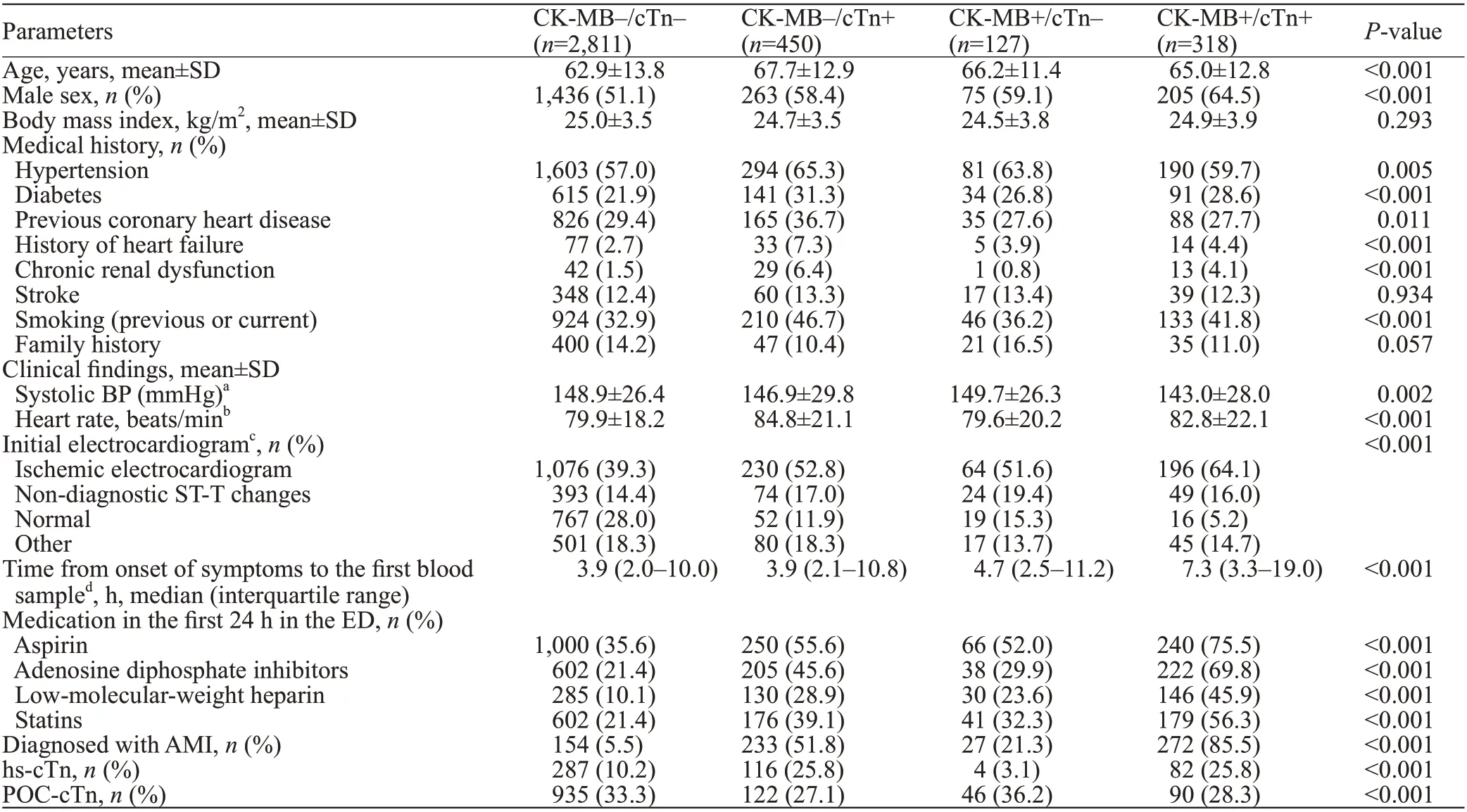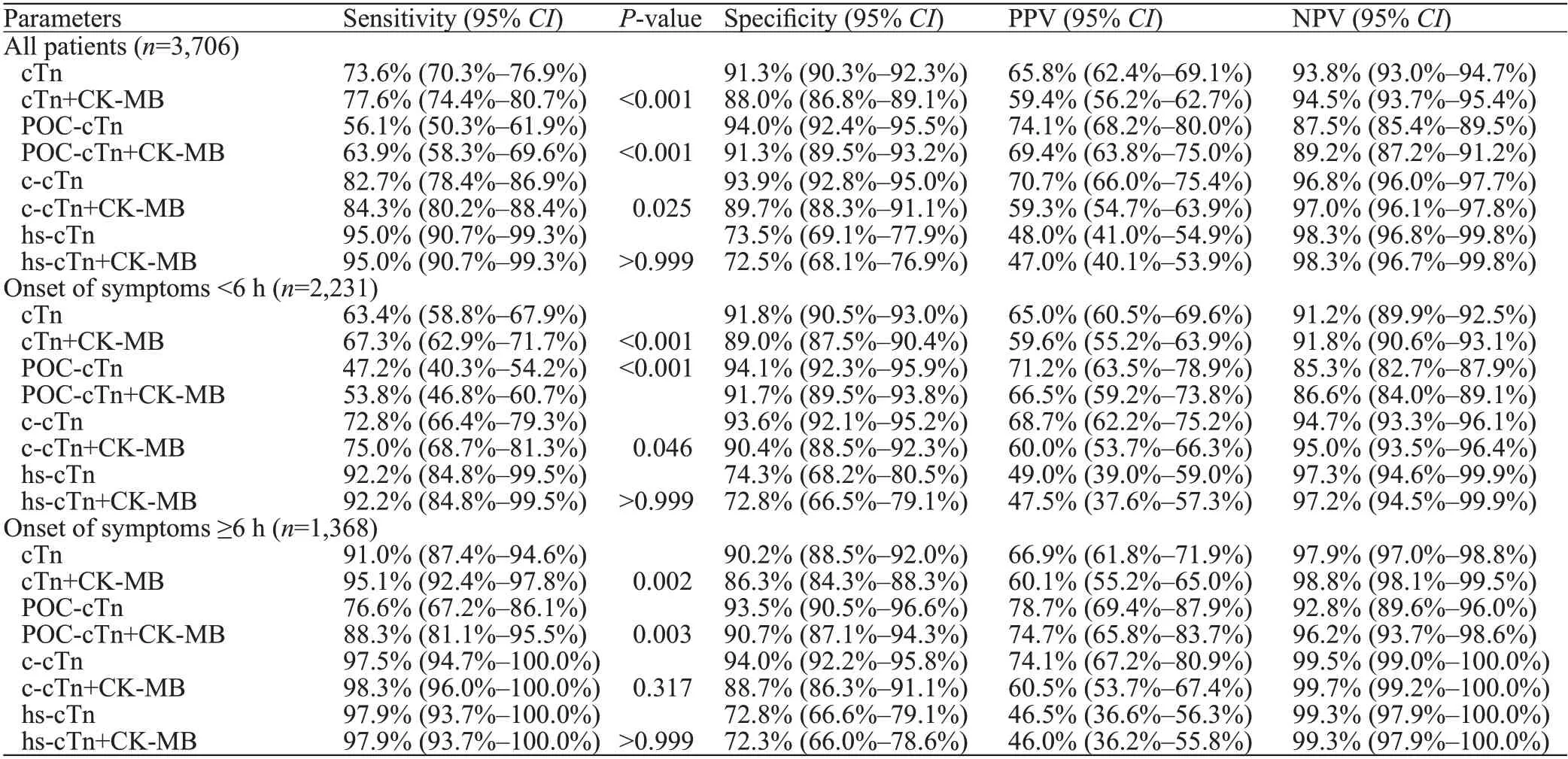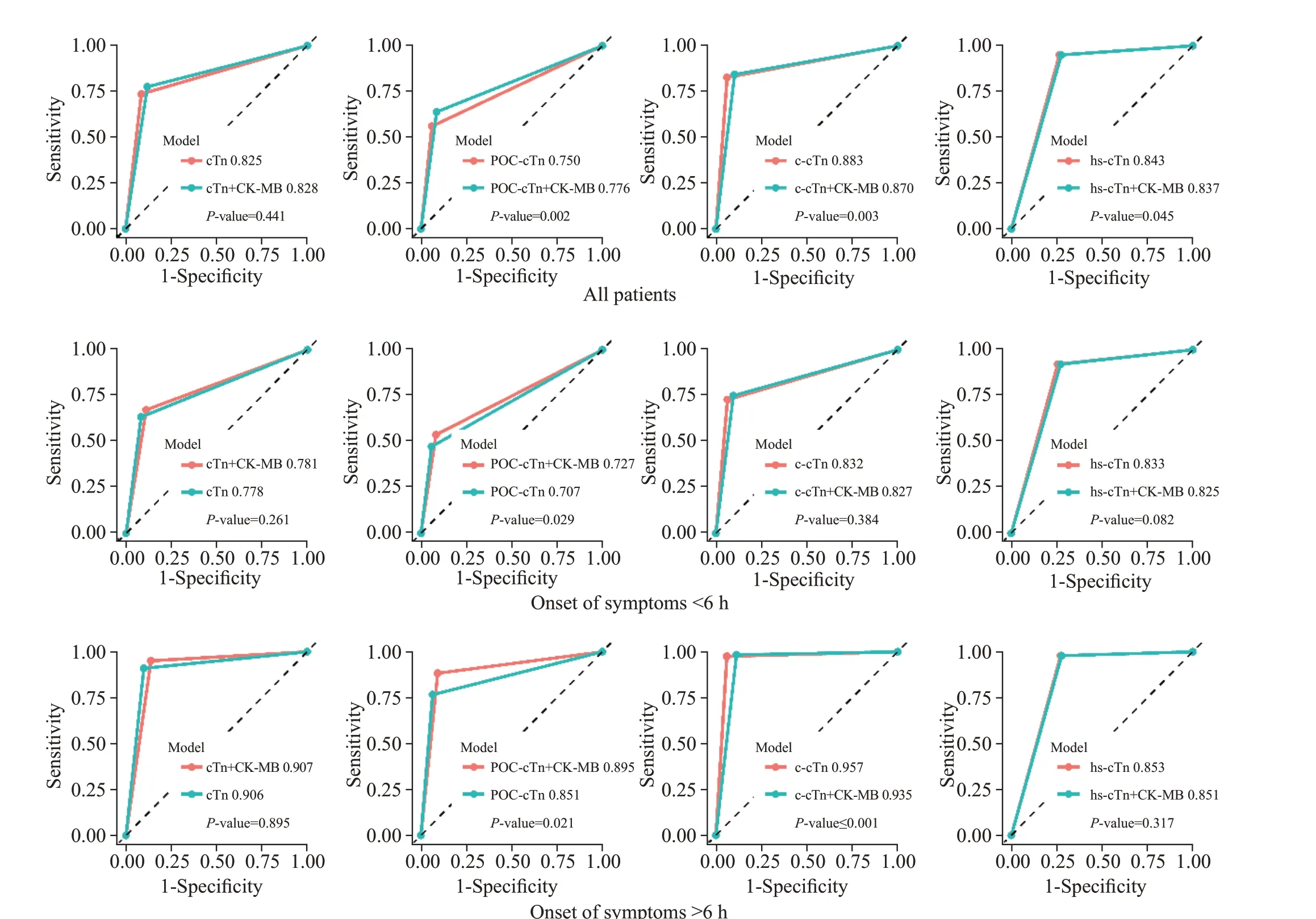The combination of creatine kinase-myocardial band isoenzyme and point-of-care cardiac troponin/contemporary cardiac troponin for the early diagnosis of acute myocardial infarction
Guang-mei Wang, Yong Li, Shuo Wu, Wen Zheng, Jing-jing Ma, Feng Xu, Jia-qi Zheng,He Zhang, Jia-li Wang, Yu-guo Chen
1 Department of Emergency Medicine, Qilu Hospital of Shandong University, Jinan 250012, China
2 Shandong Provincial Clinical Research Center for Emergency and Critical Care Medicine; Institute of Emergency and Critical Care Medicine of Shandong University; Chest Pain Center; Qilu Hospital of Shandong University, Jinan 250012,China
3 Key Laboratory of Emergency and Critical Care Medicine of Shandong Province; Key Laboratory of Cardiopulmonarycerebral Resuscitation Research of Shandong Province; Shandong Provincial Engineering Laboratory for Emergency and Critical Care Medicine; Qilu Hospital of Shandong University, Jinan 250012, China
4 Key Laboratory of Cardiovascular Remodeling and Function Research, Chinese Ministry of Education, Chinese Ministry of Health and Chinese Academy of Medical Sciences; The State and Shandong Province Joint Key Laboratory of Translational Cardiovascular Medicine; Qilu Hospital of Shandong University, Jinan 250012, China
KEYWORDS: Creatine kinase-myocardial band isoenzyme; Cardiac troponin; Acute myocardial infarction; Emergency department
INTRODUCTION
Cardiac biomarkers are important to evaluate patients with suspected acute myocardial infarction (AMI). The European Society of Cardiology recommends the use of high-sensitive cardiac troponin (hs-cTn) assays in rapid rule-in or rule-out protocols for the early evaluation of potential AMI patients. However, not every institution is equipped with hs-cTn assay. For these institutions, how to make rapid and correct AMI diagnosis and initiate early appropriate treatment remains challenging.
Many commercial cardiac troponin (cTn) assays are widely used in clinical practice, but the analytical performance of cTn assays varies. They could be categorized into three types: point-of-care cTn (POCcTn) assays, contemporary cTn (c-cTn) assays,and hs-cTn assays.POC-cTn assays measure cTn concentrations within 30 min but have lower clinical sensitivity. While c-cTn and hs-cTn assays have higher sensitivity, they cannot be obtained within 30 min.The sensitivity of CK-MB and cTn, which arises within 3–4 h after injury, is not optimal until 6 h after myocardial injury.After combining CK-MB and cTn, we aim to evaluate: (1) whether the combination contributes to the early diagnosis of AMI; (2) whether the incremental values are related to cTn types and the time from symptom onset to testing.
METHODS
Study setting and population
This was a secondary analysis of a prospective observational cohort. Patients were prospectively enrolled at nine sites. Six sites were located in Shandong Province,including four tertiary and two secondary hospitals. The other three tertiary hospitals were located outside Shandong Province. Overall enrollment occurred between September 1, 2015, and September 30, 2017; however, not all sites collected data throughout the entire study period.
Patients aged 18 years or older who presented with acute nontraumatic chest pain or acute coronary syndrome (ACS)-related symptoms within the last 24 h were recruited. In accordance with the American College of Cardiology Foundation/American Heart Association key data elements and definitions, ACS-related symptoms may include arm pain, jaw pain, nausea,vomiting, or other equivalent discomfort suggestive of myocardial ischemia.Patients were excluded if they did not draw blood for CK-MB or cTn detection or if they were transferred from another tertiary or secondary hospital. Patients were also excluded if they had STsegment elevation myocardial infarction. The treating physicians identif ied eligible patients. Research assistants screened all ED visits daily to capture the eligible patients as completely as possible. According to the cTn assays used,the patients were allocated to three groups: the POC-cTn group, the c-cTn group, and the hs-cTn group.
The study was approved by the central ethics committee at Qilu Hospital of Shandong University. All sites obtained central ethics approval except for one site, which obtained local approval. All enrolled patients provided written informed consent. All methods were performed in accordance with the relevant guidelines and regulations.
Data collection
Each site used standardized case report forms applying clinical data standards to collect data by trained research staff.The time points and numbers of blood samples for the determination of cardiac biomarkers were left to the discretion of the attending physicians. The levels of cardiac biomarkers were measured with the local biomarker assay. Only the baseline CK-MB and cTn values were used for the purpose of the analysis. Information on CK-MB and cTn at every site was assessed (supplementary Tables 1 and 2). The patients were followed up at 30 d after discharge by telephone. A death registry review was used to follow up patients who could not be contacted. To guarantee the integrity and authenticity of the data, an electronic data capture system was used.
The final ED diagnoses were adjudicated by two independent cardiologists according to all clinical information from ED presentation to follow-up. In situations of disagreement about the diagnosis, face-toface meetings were conducted at regular intervals, and a third cardiologist reviewed and adjudicated the cases.In brief, AMI referred to type I AMI and was diagnosed when there was evidence of myocardial necrosis in a clinical setting consistent with acute myocardial ischemia caused by atherosclerotic plaque disruption. It was based on serial cTn measurements. A rise and/or fall in cTn values with at least one value above the diagnostic threshold and a minimum of a 20% cTn concentration change were required.
Statistical analysis
Continuous variables were presented as mean±standard deviation or median (interquartile range), and categorical variables as numbers and percentages. Between groups,comparisons were performed by one-way analysis of variance (ANOVA), or Kruskal-Wallis test for continuous variables, and Chi-squared test for categorical variables, as appropriate. We assessed the diagnostic performance of the cTn assay alone and in combination with CK-MB with sensitivity, specificity, negative predictive value, positive predictive value, and receiver operating characteristic (ROC) curves. The sensitivities were compared using the McNemar test.The area under the curve (AUC) was compared by MedCalc.All hypothesis testing was two-tailed, and a-value less than 0.05 was considered statistically significant. All statistical analyses were performed using SAS 9.4 (SAS Institute Inc., USA).
RESULTS
Patient population
There were 4,101 patient visits in the registry, and 395 patients were excluded because only cTn levels(=331) or CK-MB levels (=64) were obtained on the f irst specimen. Among 3,706 patients with available cTn and CK-MB levels on the first specimen, POC assays were used in 1,193 (32.2%) patients to test cTn levels,hs-cTn assays were used in 489 (13.2%) patients, and c-cTn assays were used in the remaining patients. AMI was the adjudicated final diagnosis in 686 (18.5%)patients. For the first blood draw, 445 (12.0%) patients were CK-MB+, and 768 (20.7%) patients were cTn+.The majority of patients had concordant results: 2,811(75.8%) patients were CK-MB–/cTn–, and 318 (8.6%)patients were CK-MB+/cTn+. The CK-MB and cTn results were discordant in 577 (15.6%) patients. Among these patients, 450 (12.1%) patients were CK-MB–/cTn+,and 127 (3.4%) patients were CK-MB+/cTn–.
The basic characteristics of the patients are shown in Table 1. The CK-MB–/cTn– group included younger patients and more females. This group had lower incidences of hypertension, diabetes and prior heart failure,fewer smokers, and more normal electrocardiograms (ECGs)than the other groups. The CK-MB+/cTn+ group had more males, more ischemic ECGs and detected cardiac biomarkers later after the onset of chest pain. CK-MB–/cTn+ patients were older and had more cardiac risk factors and a higher heart rate than those in the other groups. Patients in the CKMB+/cTn– group had less previous coronary heart disease and chronic renal dysfunction and had a higher proportion of POC testing.
Fewer patients with CK-MB+ had previous coronary heart disease regardless of cTn status. More patients with cTn+ had diabetes, chronic renal dysfunction, a smoking history, and a higher heart rate regardless of CK-MB status.
Diagnostic performance
The sensitivity of combining CK-MB and cTn increased compared to that of the single cTn approach when POC-cTn assays or c-cTn assays were used (56.1%vs. 63.9%,<0.001; 82.7% vs. 84.3%,=0.025). In the subgroup analysis, when POC-cTn assays were used,the sensitivity of the combination of CK-MB and cTnincreased signif icantly compared to that of the single cTn approach regardless of the time from chest pain onset to testing. The sensitivity of combining CK-MB and c-cTn increased compared to that of c-cTn alone in patients who had blood samples drawn within 6 h of chest pain onset (72.8% vs. 75.0%,=0.046), while the sensitivity did not significantly increase in patients who had biomarkers assessed after at least 6 h of chest pain onset(97.5% vs. 98.3%,=0.317). However, in the analysis of 485 patients who used hs-cTn assays, CK-MB did not provide additional value, regardless of the time from chest pain onset to testing (Table 2).

Table 1. Basic characteristics of analyzed patients
The AUC of the combination of CK-MB and cTn signif icantly increased compared to that of the single cTn protocol when POC assays were used, regardless of the time from chest pain onset to testing. However, the AUC significantly decreased when c-cTn or hs-cTn assays were used (0.883 vs. 0.870,=0.003; 0.843 vs. 0.837,=0.045). The AUC of the combination of CK-MB and c-cTn did not significantly decrease compared to that of c-cTn alone (0.832 vs. 0.827,=0.384) for patients who had blood samples drawn within 6 h from chest pain onset, while the AUC signif icantly decreased (0.957 vs. 0.935,0.001) for patients who had blood samples drawn at least 6 h from chest pain onset (Figure 1).
DISCUSSION
The early assessment of patients with acute chest pain is important and mainly depends on cardiac biomarkers, including CK-MB and cTn.Although hs-cTn is recommended as the preferred choice to identify AMI,it is not always available in every institution. In this study, we found that combining CKMB and POC-cTn signif icantly increased the diagnostic sensitivity regardless of whether it was more than 6 h from symptom onset. In addition, the combination of CK-MB and c-cTn increased in diagnostic sensitivity with time from symptom onset <6 h.However, the diagnostic capacities of the POC-cTn assay were inferior to those of the c-cTn and hs-cTn assays, even when combined with CK-MB.Nevertheless, because POC devices can take measurements very quickly at the bedside, they can decrease the triage time and medical cost, which is fundamental for emergency care.We conclude that the combination of CK-MB and POC-cTn or c-cTn may be valuable for the early diagnosis of AMI when hs-cTn is not available.
Unfortunately, the combined use of CK-MB and hscTn did not improve the diagnostic performance for AMI.We found that combining CK-MB with hs-cTn was not superior to hs-cTn alone. hs-cTn assays can accurately detect cTn at low levels and have higher sensitivity for detecting AMI at presentation.However, with increased sensitivity, there is reduced specificity, which often confuses physicians.Thus, CK-MB should not be used when hs-cTn is measured.
It is important to note that our findings support theclinical effect of baseline CK-MB and cTn but do not deny the clinical use of serial measures to guide medical decisions. With the improved performance of cTn assays,CK-MB seems to have little value at presentation, even confusing clinicians.Continuous medical education of physicians about the characteristics of local cTn assays is essential to avoid their inappropriate use and interpretation. The baseline CK-MB value only adds additional benefit when POC-cTn/c-cTn assays were used. The rational clinical use of CK-MB and cTn would decrease health expenditure without harmful clinical consequences. The ROC curves were based on the sensitivity and specif icity of AMI thresholds in the study,so the AUC cannot be compared to that of prior studies,in which ROC curves were based on the sensitivity and specif icity of continuous values.

Table 2. Diagnostic performance of cTn alone and in combination with CK-MB for the f irst detection
There are several strengths of the study. First, it was a multicenter observational cohort study that represented the use of biomarkers in the real world. Second, we enrolled consecutive patients in the electronic data capture system,comprising high-risk and low-risk patients. Third, we only evaluated the effect of baseline CK-MB and took cTn categories and the time from chest pain onset to testing into consideration. This study has several limitations.First, CK-MB and cTn were measured at the laboratories or in the ED of the participating hospitals, which caused unavoidable variation in the quality. Second, the sample size was relatively small. Third, the time of symptom onset was recalled by patients or their families, which may inf luence its accuracy. Finally, we did not take the full clinical assessment into account when assessing the diagnostic performance of cTn and CK-MB.
CONCLUSIONS
The combination of CK-MB and POC-cTn/c-cTn may be valuable for the early diagnosis of AMI,especially when hs-cTn is not available.

Figure 1. Diagnostic accuracy of cTn alone and in combination with CK-MB quantif ied by AUC. AUC: area under the curve; CK-MB: creatine kinasemyocardial band; cTn: cardiac troponin; c-cTn: contemporary cardiac troponin; hs-cTn: high-sensitivity cardiac troponin; POC: point of care.
This study was supported by grants from the National Key R&D Program of China (2017YFC0908700,2017YFC0908703); National S&T Fundamental Resources Investigation Project ( 2018FY100600, 2018FY100602); Taishan Pandeng Scholar Program of Shandong Province (tspd20181220);Taishan Young Scholar Program of Shandong Province(tsqn20161065, tsqn201812129); and Key R&D Program of Shandong Province (2020SFXGFY03, 2019GSF108073).
The study was approved by the central ethics committee at Qilu Hospital of Shandong University. All sites obtained central ethics approval except for one site, which obtained local approval. All enrolled patients provided written informed consent.
None declared.
GMW and YL contributed equally to this work.YGC, FX, and JLW contributed to the initiation, planning and conduction of the study. GMW, YL, WZ, JJM, HZ, and JQZ conducted the study supervision. GMW, YL, and SW did the analysis and interpretation of the data. GMW and YL drafted the manuscript. All authors read and approved the f inal manuscript.
All the supplementary files in this paper are available at http://wjem.com.cn.
